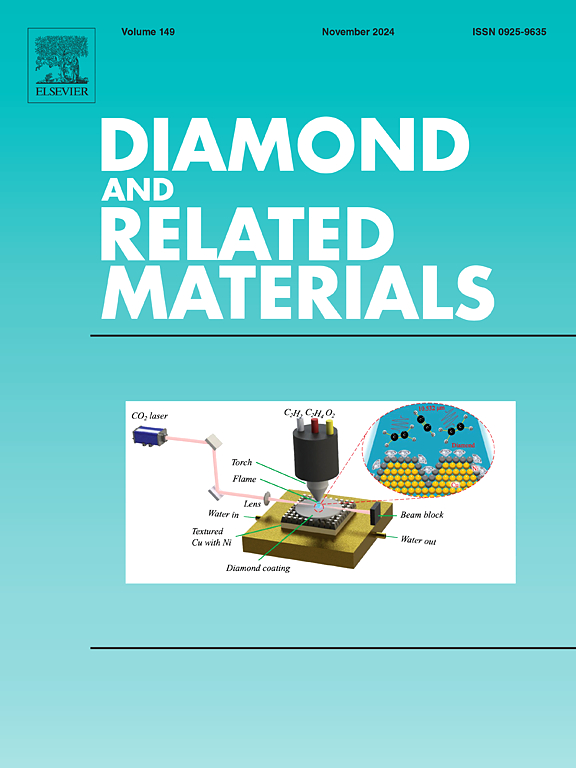Permeation selectivity of defected hexagonal boron nitrides sheets towards H2
IF 4.3
3区 材料科学
Q2 MATERIALS SCIENCE, COATINGS & FILMS
引用次数: 0
Abstract
Membranes are selective filters, can offer separation efficiencies which are difficult or impossible to achieve otherwise. Herein, the permeability potential of defected hexagonal boron nitride sheet for several environmentally important gaseous molecules is explored. The considered defects are mono-vacancy, divacancy and tri-vacancy. The results illustrate that the nature of the defect besides pore morphology has significant effect on the permeation ability for gas molecules. The barriers are drastically higher for boron vacancy hexagonal boron nitride sheet VB-h-BN and range from 73 kcal mol−1 for H2 to 442 kcal mol−1 for CO. The barriers are drastically higher for species where incoming atom is electronegative and has highly unfavorable interactions with the nitrogen atoms in the defect. An inverse effect is observed for permeation through VB-h-BN defect mainly due to the presence of electropositive boron atoms in the defect. Quite significant selectivity for H2 permeation is observed for VB(2N)-h-BN sheet where the barriers for H2 permeation is at least 20 kcal mol−1 lower than any other species (BeH2 and BeF2). The lowest barrier for H2 permeation (8.38 kcal mol−1) with even higher selectivity is observed for VN(2B)-h-BN sheet. The lower permeation barrier is seen for H2 gas which is 1.01 kcal mol−1 large size VB(2N)-h-BN nanosheet which is further decreases in aqueous medium. These results clearly demonstrate that fine tuning the nature and size of defect can offer purification of H2 from a mixture of gases which is quite for hydrogen economy. These results will promote exploration of other functional materials for the purification of H2.
缺陷六方氮化硼片对H2的渗透选择性
膜是选择性过滤器,可以提供难以或不可能达到的分离效率。本文探讨了缺陷六方氮化硼片对几种环境重要气体分子的渗透电位。所考虑的缺陷有单空位、空位和三空位。结果表明,除孔隙形态外,缺陷的性质对气体分子的渗透能力有显著影响。硼空位六方氮化硼片VB-h-BN的势垒要高得多,从H2的73 kcal mol - 1到CO的442 kcal mol - 1。当进入的原子具有电负性,并且与缺陷中的氮原子有非常不利的相互作用时,势垒要高得多。通过VB-h-BN缺陷可以观察到相反的渗透效应,这主要是由于缺陷中存在电正性硼原子。结果表明,VB(2N)-h-BN膜对H2的选择性显著,H2的渗透势垒至少比其他物质(BeH2和be2)低20千卡摩尔−1。VN(2B)-h-BN的H2渗透势垒最低(8.38 kcal mol−1),选择性更高。在大尺寸VB(2N)-h-BN纳米片中,1.01 kcal mol−1的H2气体的渗透势垒较低,在水介质中进一步降低。这些结果清楚地表明,微调缺陷的性质和大小可以从混合气体中提纯氢气,这对氢的经济性非常有利。这些结果将促进对其他功能材料的探索。
本文章由计算机程序翻译,如有差异,请以英文原文为准。
求助全文
约1分钟内获得全文
求助全文
来源期刊

Diamond and Related Materials
工程技术-材料科学:综合
CiteScore
6.00
自引率
14.60%
发文量
702
审稿时长
2.1 months
期刊介绍:
DRM is a leading international journal that publishes new fundamental and applied research on all forms of diamond, the integration of diamond with other advanced materials and development of technologies exploiting diamond. The synthesis, characterization and processing of single crystal diamond, polycrystalline films, nanodiamond powders and heterostructures with other advanced materials are encouraged topics for technical and review articles. In addition to diamond, the journal publishes manuscripts on the synthesis, characterization and application of other related materials including diamond-like carbons, carbon nanotubes, graphene, and boron and carbon nitrides. Articles are sought on the chemical functionalization of diamond and related materials as well as their use in electrochemistry, energy storage and conversion, chemical and biological sensing, imaging, thermal management, photonic and quantum applications, electron emission and electronic devices.
The International Conference on Diamond and Carbon Materials has evolved into the largest and most well attended forum in the field of diamond, providing a forum to showcase the latest results in the science and technology of diamond and other carbon materials such as carbon nanotubes, graphene, and diamond-like carbon. Run annually in association with Diamond and Related Materials the conference provides junior and established researchers the opportunity to exchange the latest results ranging from fundamental physical and chemical concepts to applied research focusing on the next generation carbon-based devices.
 求助内容:
求助内容: 应助结果提醒方式:
应助结果提醒方式:


